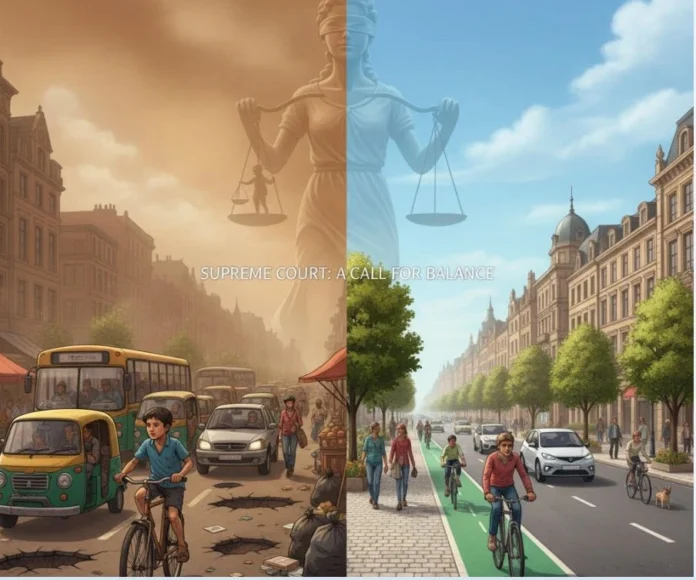By Binny Yadav
When Chief Justice of India (CJI) BR Gavai on October 7, 2025, directed all states and Union Territories to frame rules safeguarding pedestrian and cyclist movement, it was more than a procedural order. It was a moral reckoning. “India’s roads are unsafe,” the CJI said—a statement that resonates across every pothole, broken footpath, and unmarked crossing in the country.
The Supreme Court’s directive, backed by Justices JB Pardiwala and KV Viswanathan, comes amid staggering numbers: over 35,000 pedestrians and 54,000 two-wheeler riders were killed in road accidents in 2023 alone. The Court lamented that India’s obsession with motorised mobility has left walkers and cyclists invisible—their rights literally trampled under wheels.
A SUNDAY MORNING SCARE
One Sunday morning, as I waited at a red light after grocery shopping, I saw a boy—barely 12—zoom past on his bicycle, narrowly avoiding a speeding sedan. When I caught up and tried to explain the danger, he broke down: “Please aunty, don’t tell my mother.”
He wasn’t reckless—just a child exercising his simplest right: to play. But in that brief ride, he risked his life for what should have been safe, ordinary freedom. That encounter spoke louder than statistics: in India, walking or cycling isn’t casual—it is courageous.
THE GRIM REALITY OF INDIAN ROADS
From Delhi’s chaotic arteries to Mumbai’s deadly intersections, Indian roads are battlegrounds. In September 2025, a BMW hit-and-run in Delhi’s Dhaula Kuan claimed the life of Navjot Singh, a senior Union finance ministry officer—a chilling echo of the infamous Salman Khan case two decades earlier.
Despite repeated public outcry, reckless driving, encroachments, and weak enforcement persist. India accounts for 11 percent of global road fatalities despite owning just one percent of the world’s vehicles. Yet the most vulnerable—walkers and cyclists—remain blamed rather than protected.
ENCROACHED FOOTPATHS, VANISHING CYCLE LANES
In Delhi, footpaths are a cruel irony—broken, occupied, or non-existent. Vendors, garbage piles, and parked cars compete for every inch meant for pedestrians. Even the capital’s “model” VIP zones fare no better.
The Rs 550-crore “Delhi Cycle Walk” project, launched in 2020 with dreams of a 200-km cycling network, lies mostly unrealised. The Chirag Dilli-Tughlakabad track, once inaugurated with fanfare, is now a chaotic strip where bikers, cyclists, and pedestrians jostle for survival.
THE LAW AND THE COURTS: A VOICE AMID NEGLECT
The judiciary has repeatedly stepped in to fill the executive vacuum. From S Rajaseekaran vs Union of India to Justice Gavai’s latest ruling, the Supreme Court has pushed for camera-based monitoring, bollards, guardrails, and regular clearance drives to reclaim pedestrian zones. Justice Gavai’s declaration that “India’s roads are unsafe” is not just a statement—it is a national wake-up call, compelling governments to reimagine urban mobility around dignity and safety.
A COMPARATIVE GAZE: WHAT INDIA CAN LEARN
In Europe, pedestrian-first planning is the norm. Crossings work, footpaths are sacred, and respect for walkers is cultural. In India, by contrast, zebra crossings fade, pavements vanish, and hawkers pay “hafta” to claim public walkways. In many cities, residents treat pavements as private parking spaces—a reflection of civic apathy and state failure.
BEYOND BLAME: WHAT MUST CHANGE
Pedestrian safety isn’t just about enforcement—it is about empathy and design. The Supreme Court’s order offers a roadmap, but implementation must follow.
The following key steps are necessary:
- Build dedicated pedestrian and cycling infrastructure into every city’s master plan.
- Deploy camera-based enforcement for encroachments and speeding.
- Integrate public transport and walkability to reduce car dependence.
- Launch mass awareness campaigns treating pedestrian safety as a civic right.
A WALK TO REMEMBER
I often think of that frightened little boy on his cycle. How many children ride to school every day—unseen, unprotected and uncounted? The data records how many die, but not how many live in daily fear of dying on roads that refuse to protect them.
Justice Gavai’s words should not fade into legal archives. They must ignite change—because the right to walk and cycle safely is not a luxury. It is a constitutional promise of life, liberty, and dignity.
Until then, every broken footpath, every red light, every reckless driver will remain a reminder that in the world’s largest democracy, even walking home is a legal struggle.
—The writer is a New Delhi-based journalist, lawyer and trained mediator


